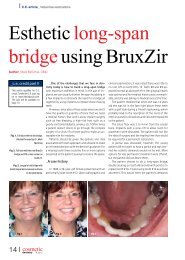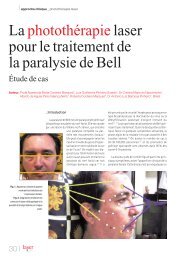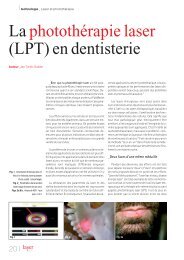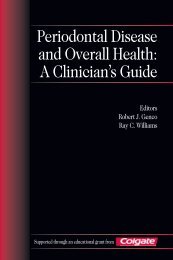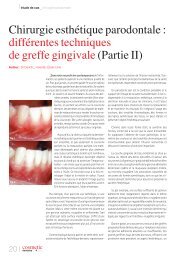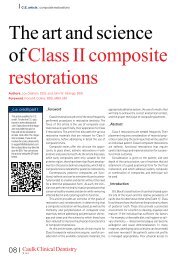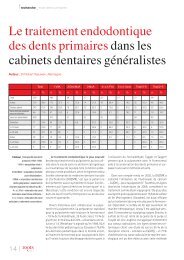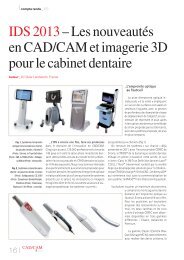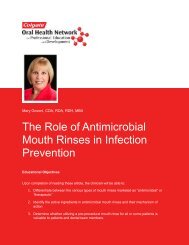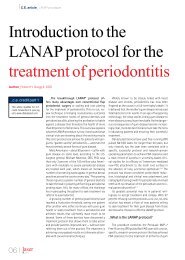Periodontal Disease and Overall Health: A Clinician's Guide
Periodontal Disease and Overall Health: A Clinician's Guide
Periodontal Disease and Overall Health: A Clinician's Guide
You also want an ePaper? Increase the reach of your titles
YUMPU automatically turns print PDFs into web optimized ePapers that Google loves.
14 <strong>Periodontal</strong> <strong>Disease</strong> <strong>and</strong> <strong>Overall</strong> <strong>Health</strong>: A <strong>Clinician's</strong> <strong>Guide</strong>control bacterial infection. In persons whoare not susceptible to periodontitis, the primarydefense mechanisms control the infection,<strong>and</strong> chronic inflammation (i.e., chronicgingivitis) may persist. However, in individualssusceptible to periodontitis, theabove inflammatory process will eventuallyextend apically <strong>and</strong> laterally to involvedeeper connective tissues <strong>and</strong> alveolar bone,recruiting monocytes <strong>and</strong> lymphocytes tothe site of infection at these later stages.These monocytes <strong>and</strong> macrophages areactivated by the bacterial endotoxins leadingto the production of high levels ofprostagl<strong>and</strong>ins (e.g., PGE 2), interleukins(e.g., IL-1α, IL-1β, IL-6), TNF-α, <strong>and</strong> MMPsby the host cells. The MMPs break downcollagen fibers, disrupting the normalanatomy of the gingival tissues, resulting indestruction of the periodontal apparatus. Ifleft untreated, the inflammation continuesto extend apically, <strong>and</strong> osteoclasts are stimulatedto resorb alveolar bone triggered bythe high levels of PGs, ILs, <strong>and</strong> TNF-α in thetissues. The elevated levels of pro-inflammatorymediators <strong>and</strong> MMPs are counterbalancedby a protective response in the hostwith elevations in anti-inflammatory mediatorssuch as the cytokines IL-4 <strong>and</strong> IL-10, aswell as other mediators such as IL-1ra (receptorantagonist) <strong>and</strong> tissue inhibitors ofMMPs (TIMPs; Figure 2). 36,37 Under normal,healthy conditions, the anti-inflammatorymediators are balanced with inflammatorymediators, thereby controlling tissue destruc -tion. If an imbalance is seen, with excessivelevels of the pro-inflammatory mediators,upregulated MMP expression <strong>and</strong> activity,<strong>and</strong> insufficient levels of protective antiinflammatorymediators, loss of periodontalconnective tissue <strong>and</strong> bone will occur.Thus, plaque bacteria initiate an inflammatoryresponse by the host, resulting inexcessive levels of pro-inflammatory mediators<strong>and</strong> enzymes, leading to the destructionof periodontal tissues. If this inflammationFigure 2. The <strong>Periodontal</strong> BalanceRisk factors (e.g., genetics,smoking, diabetes)Overproduction of proinflammatory ordestructive mediators <strong>and</strong> enzymes (e.g.,IL-1, IL-6, PGE 2, TNF-, MMPsReduction ofrisk factorsExpression of host-derived antiinflammatoryor protective mediators(e.g., IL-4, IL-10, IL-1ra, TIMPs)Underactivity or overactivityof aspects of host responseHost modulatorytherapyResolution ofinflammationPoor compliancePoor plaque controlSubgingivalbioburdenOHI, SRP, surgery, antiseptics, antibioticsto reduce bacterial challengeDISEASEHEALTHCopyright 2006 by Saunders, an imprint of Elsevier Inc.Source: Carranza’s Clinical Periodontology, 10th Ed. WB Saunders Company; 2006:275–282. 36 Reproducedwith permission.



